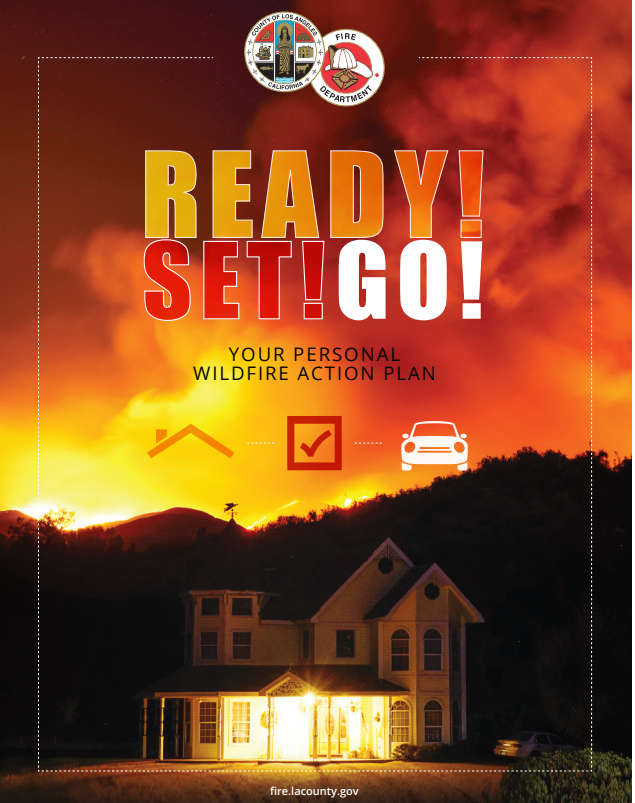Fire is, and always has been, a natural part of Southern California’s landscape. Wildfires are often fueled by dry vegetation and driven by hot, dry “Santa Ana” winds, making them extremely dangerous and difficult to control. Fire season is now year-round and requires everyone to be on heightened alert, especially for those living in wildland area communities.
Follow the steps from the Los Angeles County Fire Department’s Ready! Set! Go! Your Personal Wildfire Action Plan to protect yourself, your family and home from a devastating wildfire.
“Ready” – Prepare Your Home and Property
Create and maintain a proper defensible space around your home. This is essential for increasing your home’s chance of surviving a wildfire. Three zones make up the 200 feet of required defensible space:
- Zone 1: Extends 30 feet out from structure. Remove woodpiles and debris, cut or mow annual grass to 3 inches or less, and trim tree branches within this zone. Irrigation is recommended to maintain moisture content.
- Zone 2: Extended from the outer edge of Zone 1 to 100 feet out from the structure. Cut or mow annual grass to 3 inches or less, create vertical and horizontal spacing between trees and shrubs, and remove debris (a mulch layer to a depth of four inches may be permitted if erosion control is an issue) within this zone. Irrigation is recommended to maintain moisture content.
- Zone 3: Extends from the outer edge of Zone 2 to 200 feet out from the structure. Zone 3 consists of mostly native plants thinned by 30 to 50 percent. The objective is to reduce vegetation density and overall fuel load. This slows the rate of fire spread, reducing flame lengths and fire intensity before it reaches irrigated zones or structures.
Safeguard the physical structure of your home and areas of your property from wildfire. This includes properly preparing your roof (the most vulnerable area of your home to wind blown embers), cleaning and/or enclosing rain gutters to limit build up of flammable debris, and covering vents and eaves with fire resistant metal mesh.
“Set” – Create a Wildfire Action Plan
Prepare the Plan. The whole family should be involved in developing your plan. The following steps are a great place to start:
- Identify Contact Information: Identify and document important phone numbers (emergency contacts, contact info for children’s schools, etc.)
- Review and Back-up Important Documents: Review your insurance coverage and make sure you are properly covered in case of wildfire. Compile important documents (insurance info, passports, marriage license, birth certificates, etc.) into a safe, easy to access location to quickly take with you during an evacuation. Store physical copies of documents at a family members house or utilize secure cloud based systems to store digital copies.
- Gather Supplies: Develop a “go-bag” with essential supplies for your family that can be grabbed quickly during an evacuation. Ensure medication, water, food, and other important items are considered based on your individual needs.
- Prepare for Evacuation: Designate an emergency meeting location outside the hazard area. Identify several different routes to leave your home in case one or more are blocked. Have all supplies for children, people with disabilities or others with access and functional needs, and/or pets identified and/or packed. If you know you will need extra time to evacuate, be prepared to leave early (even before official notice).
“GO!” – Take Action When Wildfire Strikes
When wildfire strikes and evacuation becomes necessary, implement your plan and consider the following:
- Evacuation Notices: Sign up for Alert LA County emergency notifications! In Los Angeles County, officials will often issue “Evacuation Warnings” when a wildfire may soon threaten a certain area. Everyone should be set to go at this stage and those who need more time evacuating should leave now. When there is an imminent threat to life and property, officials will issue “Evacuation Orders”, which is a lawful order to evacuate and remain out of an area. Everyone should leave when an Order is issued. In an intense wildfire, danger may be present before authorities can issue an Evacuation Order. Don’t wait to be told by authorities to leave if you feel you are in danger.
- When to Go: Leave early enough to avoid being caught in fire, smoke, or road congestion. Don’t wait to be told by authorities to leave. In an intense wildfire, they may not have time to knock on every door. If you are advised to leave, don’t hesitate!
- Where to Go: Leave for a pre-determined location. It should be a low-risk area, such as a well-prepared neighbor or relative’s house, a Red Cross shelter or evacuation center, motel, etc.
- How to Get There: Have several evacuation routes in case one route is blocked by the fire or by emergency vehicles and equipment. Choose an evacuation route away from the fire.
Los Angeles County residents, renters, and business owners, including persons with disabilities and others with access and functional needs, may call 211 LA County for emergency preparedness information, and other referral services. The toll-free 2-1-1 number is available 24 hours a day and seven days a week. 211 LA County services can also be accessed by visiting https://211la.org



